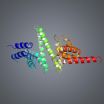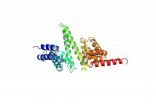(Press-News.org) Ribosomes are vital to the function of all living cells. Using the genetic information from RNA, these large molecular complexes build proteins by linking amino acids together in a specific order. Scientists have known for more than half a century that these cellular machines are themselves made up of about 80 different proteins, called ribosomal proteins, along with several RNA molecules and that these components are added in a particular sequence to construct new ribosomes, but no one has known the mechanism that controls that process.
Now researchers from Caltech and Heidelberg University have combined their expertise to track a ribosomal protein in yeast all the way from its synthesis in the cytoplasm, the cellular compartment surrounding the nucleus of a cell, to its incorporation into a developing ribosome within the nucleus. In so doing, they have identified a new chaperone protein, known as Acl4, that ushers a specific ribosomal protein through the construction process and a new regulatory mechanism that likely occurs in all eukaryotic cells.
The results, described in a paper that appears online in the journal Molecular Cell, also suggest an approach for making new antifungal agents.
The work was completed in the labs of André Hoelz, assistant professor of chemistry at Caltech, and Ed Hurt, director of the Heidelberg University Biochemistry Center (BZH).
"We now understand how this chaperone, Acl4, works with its ribosomal protein with great precision," says Hoelz. "Seeing that is kind of like being able to freeze a bullet whizzing through the air and turn it around and analyze it in all dimensions to see exactly what it looks like."
That is because the entire ribosome assembly process--including the synthesis of new ribosomal proteins by ribosomes in the cytoplasm, the transfer of those proteins into the nucleus, their incorporation into a developing ribosome, and the completed ribosome's export back out of the nucleus into the cytoplasm--happens in the tens of minutes timescale. So quickly that more than a million ribosomes are produced per day in mammalian cells to allow for turnover and cell division. Therefore, being able to follow a ribosomal protein through that process is not a simple task.
Hurt and his team in Germany have developed a new technique to capture the state of a ribosomal protein shortly after it is synthesized. When they "stopped" this particular flying bullet, an important ribosomal protein known as L4, they found that its was bound to Acl4.
Hoelz's group at Caltech then used X-ray crystallography to obtain an atomic snapshot of Acl4 and further biochemical interaction studies to establish how Acl4 recognizes and protects L4. They found that Acl4 attaches to L4 (having a high affinity for only that ribosomal protein) as it emerges from the ribosome that produced it, akin to a hand gripping a baseball. Thereby the chaperone ensures that the ribosomal protein is protected from machinery in the cell that would otherwise destroy it and ushers the L4 molecule through the sole gateway between the nucleus and cytoplasm, called the nuclear pore complex, to the site in the nucleus where new ribosomes are constructed.
"The ribosomal protein together with its chaperone basically travel through the nucleus and screen their surroundings until they find an assembling ribosome that is at exactly the right stage for the ribosomal protein to be incorporated," explains Ferdinand Huber, a graduate student in Hoelz's group and one of the first authors on the paper. "Once found, the chaperone lets the ribosomal protein go and gets recycled to go pick up another protein."
The researchers say that Acl4 is just one example from a whole family of chaperone proteins that likely work in this same fashion.
Hoelz adds that if this process does not work properly, ribosomes and proteins cannot be made. Some diseases (including aggressive leukemia subtypes) are associated with malfunctions in this process.
"It is likely that human cells also contain a dedicated assembly chaperone for L4. However, we are certain that it has a distinct atomic structure, which might allow us to develop new antifungal agents," Hoelz says. "By preventing the chaperone from interacting with its partner, you could keep the cell from making new ribosomes. You could potentially weaken the organism to the point where the immune system could then clear the infection. This is a completely new approach."
INFORMATION:
Co-first authors on the paper, "Coordinated Ribosomal L4 Protein Assembly into the Pre-Ribosome Is Regulated by Its Eukaryote-Specific Extension," are Huber and Philipp Stelter of Heidelberg University. Additional authors include Ruth Kunze and Dirk Flemming also from Heidelberg University. The work was supported by the Boehringer Ingelheim Fonds, the V Foundation for Cancer Research, the Edward Mallinckrodt, Jr. Foundation, the Sidney Kimmel Foundation for Cancer Research, and the German Research Foundation (DFG).
AUSTIN, Texas -- Researchers in the Cockrell School of Engineering at The University of Texas at Austin have developed a centimeter-accurate GPS-based positioning system that could revolutionize geolocation on virtual reality headsets, cellphones and other technologies, making global positioning and orientation far more precise than what is currently available on a mobile device.
The researchers' new system could allow unmanned aerial vehicles to deliver packages to a specific spot on a consumer's back porch, enable collision avoidance technologies on cars and allow virtual ...
SAN DIEGO, Calif. (May 5, 2015)-- Acceptance of premarital sex is at an all-time high along with an acceptance of homosexuality, find researchers led by Jean M. Twenge from San Diego State University.
The researchers -- also including Ryne Sherman from Florida Atlantic University and Brooke E. Wells from Hunter College -- analyzed data from the General Social Survey, a nationally representative survey of more than 33,000 U.S. adults taken between 1972 and 2012. They found substantial generational shifts in attitudes toward non-marital sex and number of sexual partners. ...
Using proteomics techniques to study injured optic nerves, researchers at Boston Children's Hospital have identified previously unrecognized proteins and pathways involved in nerve regeneration. Adding back one of these proteins--the oncogene c-myc--they achieved unprecedented optic nerve regeneration in mice when combined with two other known strategies. The findings were published online April 30 by the journal Neuron.
Researchers have been trying for many decades to get injured nerves in the brain and spinal cord to regenerate. Various molecules have been targeted ...
"Imagine a tiny spotlight like those used in theatres but with a light ray measuring only a few nanometres, which shines light on a given spot but leaves everything else in the dark," explains Monica Mazzolini, SISSA research scientist, "That's how the optic fibres we used in our experiment work". Mazzolini, first author of a paper just published in PNAS, literally shut herself in a "darkroom" lit with infrared light only to stimulate rods, the light-sensitive cells of the retina (for night vision), with these extremely focused light beams in vitro. In their study, Mazzolini ...
ARLINGTON HEIGHTS, Ill. (May 5, 2015) - While it may be a stereotype, it's also true that women seek medical care more frequently than men do. And a recent study shows that women with acute asthma who are treated in the emergency department (ED) are 60 percent more likely than men treated in the ED to need hospitalization.
The study, published in the Annals of Allergy, Asthma and Immunology, the scientific publication of the American College of Allergy, Asthma and Immunology (ACAAI), looked at the sex differences in patient characteristics, and risk of hospitalizations ...
DALLAS, May 4, 2015 -- More bystanders performing CPR contributed to more cardiac arrest survivors returning to work in a Danish study published in the American Heart Association journal Circulation.
In the largest study to date to examine return to work after cardiac arrest, researchers studied 4,354 patients in Denmark who were employed before they suffered out-of-hospital cardiac arrests between 2001 to 2011. Researchers found:
More than 75 percent of survivors who had a cardiac arrest outside a hospital were capable of returning to work.
Chances of returning ...
Many of us take a healthy immune system for granted. But for certain infants with rare, inherited mutations of certain genes, severe infection and death are stark consequences of their impaired immune responses.
Now, researchers at NYU Langone Medical Center have identified an important role for calcium signaling in immune responses to chronic infection resulting from Mycobacterium tuberculosis, the bacterium causing tuberculosis (TB).
Specifically, they determined that the immune systems in genetically altered mice lacking the critically important calcium channel ...
Uninsured people don't have any more difficulty getting appointments with primary care doctors than those with insurance, but they get them at prices that are likely unaffordable to a typical uninsured person, according to new Johns Hopkins Bloomberg School of Public Health-led research.
And payment options are not very flexible, with only one in five people told they could be seen without paying the whole cost up front, suggests the new study published in the May issue of the journal Health Affairs.
"There's a discouragement factor for uninsured people when it comes ...
A new screening method can detect twice as many women with ovarian cancer as conventional strategies, according to the latest results from the largest trial of its kind led by UCL.
The method uses a statistical calculation to interpret changing levels in women's blood of a protein called CA125, which is linked to ovarian cancer. This gives a more accurate prediction of a woman's individual risk of developing cancer, compared to the conventional screening method which uses a fixed 'cut-off' point for CA125. The new method detected cancer in 86% of women with invasive epithelial ...
ATLANTA -- May 4, 2015 -- While black and white men under age 65 diagnosed with early-stage breast cancer received similar treatment, blacks had a 76% higher risk of death than whites, according to a new study. The study, published in the Journal of Clinical Oncology, found that the disparity was significantly reduced after accounting for differences in insurance and income.
Male breast cancer is a rare disease, accounting for less than 1% of all cancers in men and approximately 2% of all breast cancers in the United States. Black men have a higher incidence of breast ...

